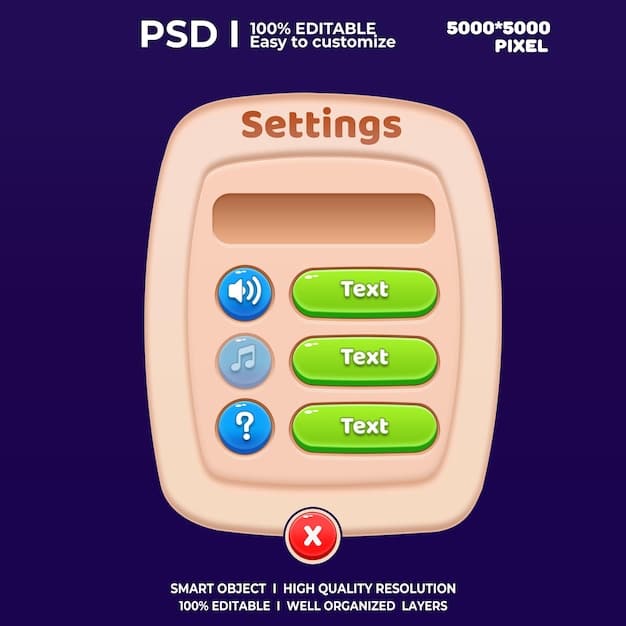Mobile Gaming Accessibility: Leveling the Playing Field for All

Mobile gaming accessibility ensures that individuals with disabilities can enjoy and engage with games through adapted controls, visual aids, and customizable settings.
The world of mobile gaming has exploded in popularity, offering a diverse range of experiences for players of all ages and backgrounds. However, for individuals with disabilities, accessing and enjoying these games can present significant challenges. Mobile gaming accessibility: games designed for players with disabilities focuses on creating inclusive gaming environments that cater to a wide spectrum of needs, ensuring that everyone can participate and have fun.
Understanding Mobile Gaming Accessibility
Mobile gaming accessibility involves designing games with features and options that accommodate players with various disabilities. This includes visual, auditory, motor, and cognitive impairments. By implementing inclusive design principles, developers can create games that are not only enjoyable but also accessible to a broader audience.
Accessibility in mobile gaming is not just about compliance with regulations; it’s about fostering a more inclusive and equitable gaming community where everyone has the opportunity to participate and enjoy the benefits of gaming.

Common Accessibility Barriers in Mobile Games
Many mobile games inadvertently pose barriers to players with disabilities. These barriers can range from complex control schemes to visual elements that are difficult to perceive. Understanding these challenges is the first step toward creating more accessible games.
- Complexity of Controls: Many mobile games require complex multi-finger gestures or rapid taps, which can be difficult for players with motor impairments.
- Visual Clutter: Overly detailed graphics, small text, and rapidly changing visual elements can be overwhelming for players with visual impairments.
- Auditory Dependence: Games that rely heavily on audio cues without providing visual alternatives can exclude deaf or hard-of-hearing players.
- Cognitive Overload: Games with complicated mechanics, confusing interfaces, and demanding puzzles can be challenging for players with cognitive disabilities.
Addressing these barriers requires a thoughtful and proactive approach to game design, ensuring that accessibility is considered from the outset rather than as an afterthought.
In conclusion, understanding the common barriers is essential for developers to create games that are inclusive and accessible to a wider audience, promoting a more equitable gaming experience.
Key Accessibility Features in Mobile Games
Implementing key accessibility features can significantly improve the gaming experience for players with disabilities. These features address various impairments and provide options for customization, making games more inclusive and enjoyable.
These features not only enhance accessibility but also contribute to a better overall gaming experience for all players, regardless of their abilities.
Customizable Controls and Input Methods
One of the most impactful accessibility features is the ability to customize game controls. This allows players to adapt the input method to their specific needs and preferences.
- Remappable Buttons: Allowing players to reassign controls to different buttons or gestures can make games more accessible for those with motor impairments.
- Adjustable Sensitivity: Providing options to adjust the sensitivity of touch controls or motion sensors can help players with fine motor control issues.
- External Controller Support: Integrating support for external controllers, such as Bluetooth gamepads, can offer a more comfortable and familiar control scheme.
By offering a range of control options, developers can empower players to tailor their gaming experience to their individual capabilities.

Visual and Auditory Enhancements
Visual and auditory enhancements are crucial for players with visual or auditory impairments. These features provide alternative ways to perceive and interact with the game world.
- Adjustable Text Size and Contrast: Allowing players to increase text size and adjust color contrast can improve readability for those with low vision or colorblindness.
- Audio Cues and Subtitles: Providing clear audio cues and comprehensive subtitles can help deaf or hard-of-hearing players understand important game information.
- Screen Readers: Integrating support for screen readers can enable visually impaired players to navigate menus and receive feedback on their actions.
These enhancements ensure that players with visual or auditory impairments can fully engage with the game without missing critical information.
Implementing these key accessibility features can transform a game from being inaccessible to inclusive, ensuring that more players can enjoy the experience.
Examples of Accessible Mobile Games
Several mobile games have successfully implemented accessibility features, demonstrating that it is possible to create inclusive gaming experiences without compromising gameplay or aesthetics. These examples serve as valuable models for other developers.
These games showcase the potential for accessible mobile gaming and inspire other developers to prioritize inclusivity in their designs.
“A Blind Legend”
“A Blind Legend” is an audio-only adventure game designed specifically for visually impaired players. The game uses 3D binaural sound to create an immersive and navigable environment, allowing players to explore and interact with the game world using only their hearing.
The game’s innovative use of audio creates a unique and engaging experience, demonstrating the potential of audio-based games for visually impaired players.
“Color Switch”
“Color Switch” is a simple yet addictive arcade game that features color-based gameplay. While not initially designed with accessibility in mind, the game has been praised for its high contrast visuals and straightforward mechanics, which make it accessible to players with certain visual impairments and cognitive disabilities.
The game’s simplicity and clear visual design serve as an example of how unintentional accessibility can benefit a wider range of players.
“Alto’s Odyssey”
“Alto’s Odyssey” is a visually stunning endless runner game that offers a minimalist and uncluttered aesthetic. The game’s simple controls and clear visual cues make it accessible to players with motor impairments and cognitive disabilities. Additionally, the game features customizable audio settings, allowing players to adjust the sound to their preferences.
By prioritizing simplicity and clarity in its design, “Alto’s Odyssey” provides an accessible and enjoyable experience for a diverse audience.
These examples highlight the various ways in which mobile games can be made more accessible, demonstrating that inclusivity can enhance the gaming experience for all players.
The Role of Game Developers
Game developers play a crucial role in advancing mobile gaming accessibility. By adopting inclusive design principles and prioritizing accessibility features, developers can create games that are enjoyable and accessible to a wider audience.
Developers who embrace accessibility not only expand their potential player base but also contribute to a more inclusive and equitable gaming community.
Inclusive Design Principles
Inclusive design is a design philosophy that emphasizes creating products and experiences that are usable by people of all abilities. Applying inclusive design principles to mobile game development involves considering the needs of players with disabilities from the outset.
- Perceivability: Ensuring that all game elements are perceivable to players with different sensory abilities, through visual, auditory, and tactile feedback.
- Operability: Designing game controls and interfaces that are easy to operate for players with motor impairments.
- Understandability: Creating clear and intuitive game mechanics and interfaces that are easy to understand for players with cognitive disabilities.
- Robustness: Ensuring that games are compatible with assistive technologies, such as screen readers and alternative input devices.
By following these principles, developers can create games that are inherently more accessible and inclusive.
Testing and Feedback
Testing games with players with disabilities is essential for identifying and addressing accessibility issues. Gathering feedback from diverse perspectives can help developers uncover usability challenges and refine their designs.
Incorporating feedback from players with disabilities throughout the development process can lead to more accessible and user-friendly games.
Game developers have the power to create more inclusive and accessible gaming experiences by embracing inclusive design principles and actively seeking feedback from players with disabilities.
Assistive Technologies and Adaptations
Assistive technologies and adaptations play a significant role in enabling players with disabilities to access and enjoy mobile games. These tools and techniques provide alternative ways to interact with games and overcome accessibility barriers.
These technologies and adaptations not only enhance accessibility but also empower players to customize their gaming experience to their individual needs and preferences.
Screen Readers and Voice Control
Screen readers are software programs that convert text and other visual elements on a screen into speech or Braille output. These tools enable visually impaired players to navigate menus, read in-game text, and receive feedback on their actions.
Voice control software allows players to control games using spoken commands. This can be particularly useful for players with motor impairments who have difficulty using touch controls or physical controllers.
Adaptive Controllers and Input Devices
Adaptive controllers are specialized input devices designed to accommodate players with motor impairments. These controllers often feature customizable buttons, joysticks, and switches that can be configured to meet individual needs.
Alternative input devices, such as eye-tracking systems and head-tracking devices, provide hands-free control options for players with severe motor impairments.
Assistive technologies and adaptations are essential for enabling players with disabilities to access and enjoy mobile games, providing alternative ways to interact with games and overcome accessibility barriers.
The Future of Mobile Gaming Accessibility
The future of mobile gaming accessibility looks promising, with increasing awareness and advancements in technology driving innovation and inclusivity. As more developers prioritize accessibility and new assistive technologies emerge, the gaming landscape is becoming more equitable and accessible for all.
The continued focus on accessibility will not only benefit players with disabilities but also enhance the gaming experience for all players, creating a more inclusive and vibrant gaming community.
Advancements in AI and Machine Learning
Artificial intelligence (AI) and machine learning (ML) technologies have the potential to revolutionize mobile gaming accessibility. AI-powered systems can automatically detect and address accessibility issues, provide real-time adaptations, and personalize the gaming experience based on individual needs.
For example, AI algorithms can analyze gameplay and automatically adjust difficulty levels, provide visual or auditory cues, or remap controls to better suit a player’s abilities.
Collaboration and Awareness
Collaboration between game developers, accessibility experts, and players with disabilities is crucial for advancing mobile gaming accessibility. By working together, stakeholders can share knowledge, identify best practices, and develop innovative solutions.
Raising awareness about mobile gaming accessibility through advocacy, education, and outreach can help promote inclusivity and encourage developers to prioritize accessibility in their designs.
The future of mobile gaming accessibility is bright, with advancements in technology, increased collaboration, and growing awareness driving positive change and creating a more inclusive gaming world for all.
| Key Point | Brief Description |
|---|---|
| 🎮 Accessible Design | Creating games usable by people of all abilities. |
| ⚙️ Custom Controls | Remapping, sensitivity adjustments, and external controller support. |
| 🔊 Visual/Audio Cues | Adjustable text, contrast, subtitles for inclusivity. |
| 🤖 AI Adaptations | AI adjusts difficulty and offers real-time support. |
Frequently Asked Questions (FAQ)
▼
Mobile gaming accessibility refers to the design and development of mobile games that are usable and enjoyable by people of all abilities, including those with visual, auditory, motor, or cognitive impairments.
▼
It ensures inclusivity, allowing everyone to participate in gaming, and promotes fairness and equal opportunities for all players, regardless of their abilities or disabilities.
▼
Common options include customizable controls, adjustable text size and contrast, audio cues and subtitles, screen reader support, and compatibility with assistive technologies and adaptive controllers.
▼
They should adopt inclusive design principles, test games with players with disabilities, gather feedback, and prioritize accessibility features throughout the game development process for better results.
▼
The future includes advancements in AI, machine learning, increased collaboration, and rising awareness, driving innovation and creating games that are more equitable and accessible to all.
Conclusion
Mobile gaming accessibility is not just a matter of compliance; it’s about creating inclusive and enjoyable experiences for all players. By understanding the challenges faced by individuals with disabilities, implementing key accessibility features, and embracing inclusive design principles, developers can unlock the full potential of mobile gaming and foster a more equitable and vibrant gaming community.





